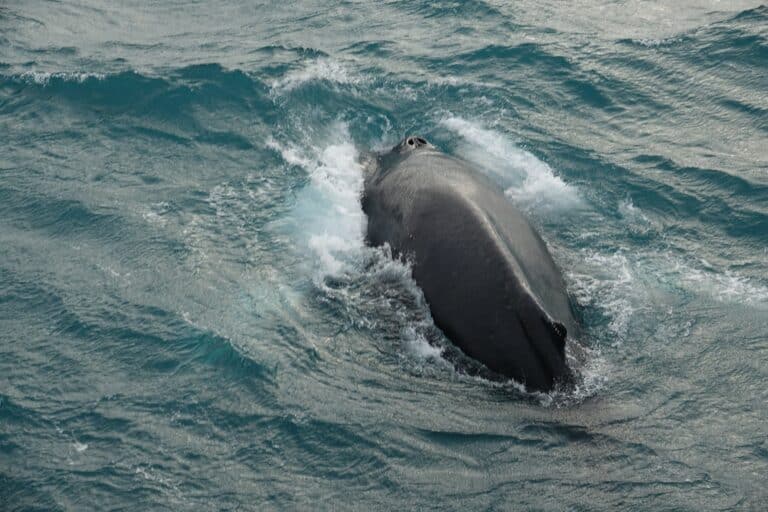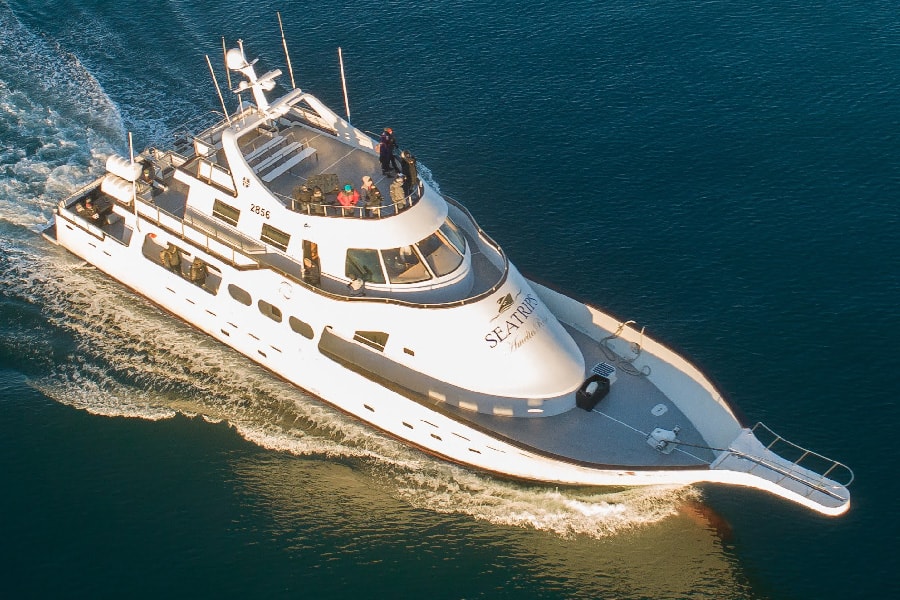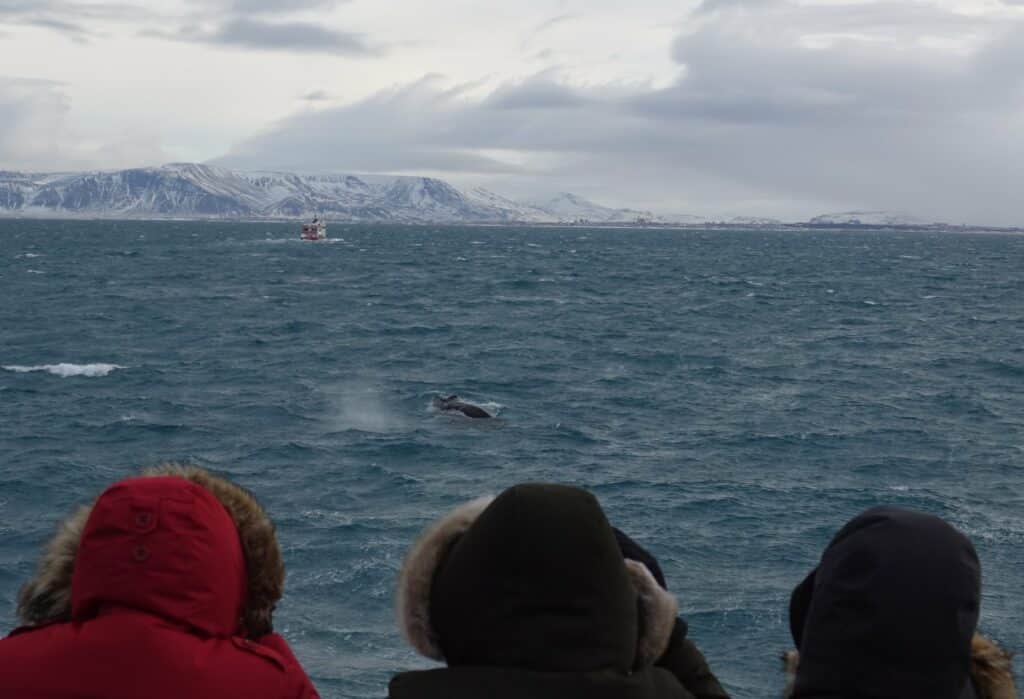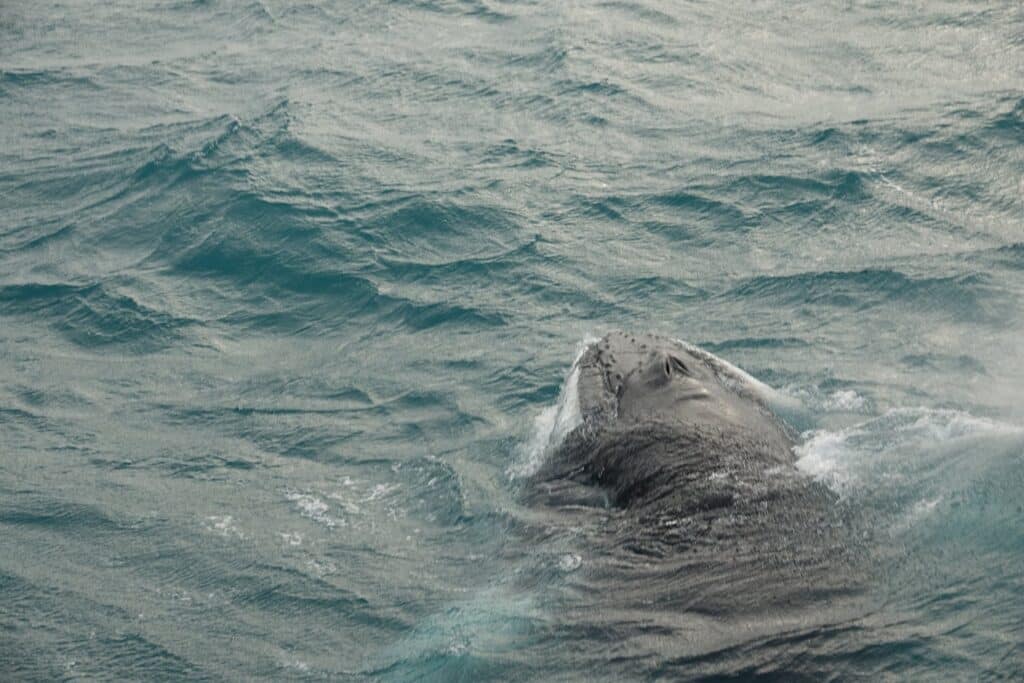What an Epic Whale Watching tour. Two different humpback whales diving around the yacht.

By Lucky Byfleet
Now the migratory whales have come to spend the summer in Iceland we are seeing more and more friendly fins… that’s like friendly faces but for whales, as we identify them by their fins.
The day was a little blowy, but bright, and we were excited to go out whale watching and see what the oceans were holding for us. We set out from Reykjavik on our superyacht, Amelia Rose, ready for a beautiful day on a beautiful yacht! As we headed out we saw huge groups of sea birds almost at the horizon to the North West.
Seabirds are wonderful in their own right, but as whale spotters they are really useful to us. We use them, alongside lots of other techniques to find cetaceans. How does that work?
Well, when whales feed they will often drive the fish towards the surface, as to a fish that is a wall! They can’t escape. For the birds, the fish become easy pickings. Despite the massive size of whales, they eat the same types of small fish as the birds. The whales are bringing the fish to them, so they don’t have to dive down and hunt. Whilst some birds like puffins are extremely agile hunters underwater many aren’t, and couldn’t easily outmanoeuvre their prey. The birds, flying above the water can see where the whales are and follow them! We follow the birds.
Do you want a head start before you go whale watching? Learn how to spot whales for free!
We headed towards the great flocks of birds, carefully watching beneath them for any fins or blow. But nothing. Whilst birds can be a great indicator of cetaceans it’s no guarantee. However what it did show us was that there was a lot of fish in the area, so we cruised in that area, staying in about the same depth of water. Whale watching is often a waiting game, so we waited patiently, enjoying being on board a luxury yacht. It was built to go across the great Atlantic and Pacific oceans, so it kept steady in the swell.
Iceland attracts whales because of the fish, and the fish breed here in great numbers thanks to the number of nutrients carried north by the gulf stream. It’s also the reason that Iceland is pretty warm, given how far north we are! The humpback whales don’t feed as they migrate, so when they get here they are keen to feed, making it a great place to go whale watching.

We sat calmly, chatting and watching puffins on the water for about twenty minutes, and then we saw a blow ahead of us, followed by a tremendous splash! It was a lazy breach – a half jump by a whale. It was undeniably a humpback, a large baleen whale known for their huge pectoral fins and acrobatic breaching displays. We got closer, whilst respecting the whale’s space and allowed it to approach us. As we did so we spotted more blows and saw it gracefully rising and breathing, then diving down to feed.
Because the whales were feeding at depth today it meant we had great displays of the iconic tails as they dove down to feed. This is the kind of whale watching we always want. Everyone got great photos, and we could identify the two whales. They have both been seen in Faxafloi many times before, so it is really great to see them again after the winter. By looking at the differences in the fluke patterns we could confirm our suspicion that there were two whales swimming around us – something that can be tricky if they don’t surface at the same time!
For more information on how we search for whales and dolphins, and learn how to be a pro-cetacean spotter yourself have a look at our guide here.
Many people come to see the wonderful wildlife here, especially on whale watching cruises, but they also come to see the incredible northern lights, and we take people out again on our lovely super yacht Amelia Rose. When you book a whale watching tour with us you get 50% off your northern lights tour!
Sea Trips Reykjavik go whale watching almost every day from Reykjavík Old Harbour, Iceland. Our yacht Amelia Rose was built as a superyacht in 2003 and as such is extremely comfortable and stable, with three viewing decks, a bar, and plenty of comfortable seating. However the seas often change here, and people are affected differently by the movement of the oceans. As such we have seasickness tablets available for free at the bar. We also have warm blankets and ponchos around the yacht for your comfort, though the inside of the ship is extremely warm and snug.
For more information on our boats, our trips and any accessibility questions please email us at seatrips@seatrips.is or read through our FAQs.

What is the difference between baleen and toothed whales?
We see both toothed and baleen whales here in Reykjavik harbour, Iceland. Did you know that dolphins and porpoises are also part of the same family? www.uk.whales.org is a brilliant website that goes into a lot more detail however this is the basic description!
They write that;
“Baleen whales have baleen plates, or sheets, which sieve prey from seawater. Toothed whales have teeth and they actively hunt fish, squid and other sea creatures. Dolphins and porpoises all have teeth and rather confusingly are known as ‘toothed whales’ too!
Another obvious difference between baleen and toothed whales is the number of blowholes on top of their head; baleen whales have two whereas toothed whales have one. There are only 14 baleen whale species and they are generally larger than the 76 species of toothed whales – except for the mighty sperm whale, the largest toothed whale.”
If you are interested in learning more we recommend these websites, https://www.nationalgeographic.com/animals/mammals/group/whale-facts/ and https://www.worldwildlife.org/species/whale They have a lot of extra learning materials about cetaceans all over the world.


